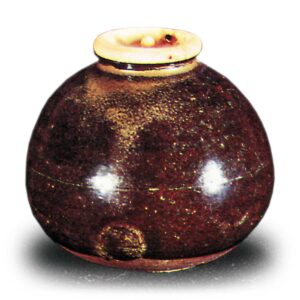
A major specialty of the period. This is an eggplant tea caddy by Han. In the “Tsuda Munenori Chayu Nikki” (Diary of a Tea Ceremony), there is a description of a tea ceremony held by Wakasaya Souka on May 18, 1573: “Toko nasubi kono jar ni kono jubo no kokuji no ya” (Eggplant on the floor, from the provincial governor of Ise), and in the “Manpou Zensho” it is described as “Kuniji nasuji Ise. The name comes from the fact that it belonged to the Kitabatake clan, the provincial governor of Ise (Mie Prefecture). The glaze is an ameishige color, with a bluish-white glaze appearing unevenly, and there are nadirs on both sides under the mouth and a round pool of glaze around the hem. The body is shaped like an eggplant with a stroked shoulder and a single line (in some places it is a little difficult to distinguish), and both the base glaze and the overglaze are very similar to those of zangetsu. It is no coincidence that it has been called one of the finest eggplant tea caddies since ancient times. After the Ise provincial governor, Kitabatake, it was passed down to Muneyoshi Wakasaya during the Tensho period (1573-192), and later became the property of Shokado (Yawatataki Honbou Shoujyo). After the Meiji Restoration, it went to the tool dealer Shoubei (known as Dokatsu) in Osaka, and around 1871 (Meiji 4), was purchased by the Wakasa domain lord Sakai Churuku for 2,000 ryo in gold and later passed down to his family. It is currently in the collection of the Fujita Museum of Art. (Ganmon Meimono Ki, Kokin Meimono Ruiju, Komeimono Ki, Rimpo Kameryu, Seto Toki Rabinokuchi, Taisho Meikikan, etc.)



